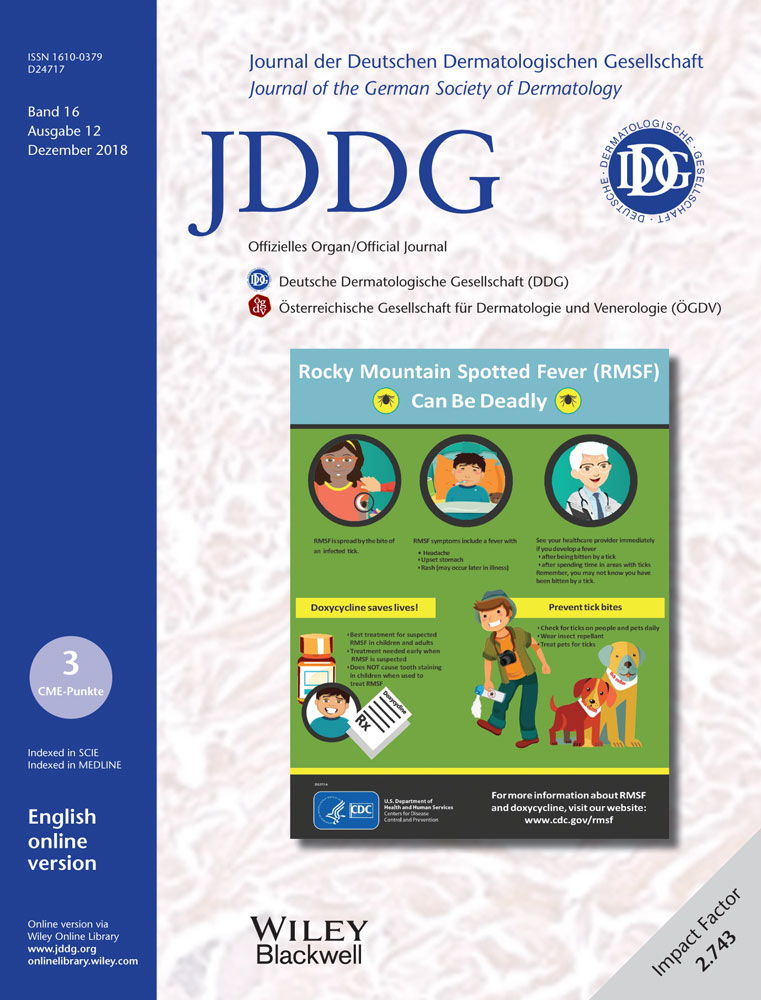Rickettsioses: Cutaneous findings frequently lead to diagnosis – a review
Section Editor
Prof. Dr. D. Nashan, Dortmund
Up to 5 % of safari tourists are affected by African tick bite fever.
Spotted fever group.
Eschar and rash are key dermatological findings.
Typhus group.
recurrent form of epidemic typhus (Brill-Zinsser disease), and murine typhus (R. typhi).
Rickettsia are small gram-negative pleomorphic rod-shaped bacteria.
Reproduction requires a host cell (obligately intracellular bacteria).
Rickettsiae are highly contagious.
Cultivation and isolation on routine culture media is not possible.
The nomenclature of Rickettsia is being continuously updated.
The majority of rickettsioses are zoonotic infections.
Vectors are arthropods, such as ticks, fleas, and mites.
Depending on the vector, the incubation period is 2–10 days.
Rocky Mountain spotted fever is associated with a high mortality.
Specific serum antibodies (IgM, IgG) can be detected no earlier than at the end of the first week after disease onset.
Species-specific PCR-based diagnostic tests are considered to be a reliable method for detecting Rickettsia in biopsy or swab specimens.
Routine laboratory tests are frequently unremarkable at the early stage of the disease.
Doxycycline (100 mg, b.i.d. for 10 days) is the treatment of choice; penicillins are not effective.
The type of exposure prophylaxis depends on the vector.
Repellants containing diethyltoluamide (DEET)
Pesticides are used Pre- and post-exposure prophylaxis with doxycycline is effective in epidemic outbreaks.
African tick bite fever (pathogen: Rickettsia africae)
Bont ticks act as vectors.
Amblyomma ticks target their prey with high speed.
In endemic areas, up to 100 % of African bont ticks are infected with Rickettsia.
The eschar at the portal of entry is a key finding.
In case of multiple inoculation sites, multiple eschars may develop.
regional lymphadenopathy.
fever, cephalgia, myalgia.
It is imperative that malaria be definitively ruled out on the day of initial presentation in every patient with nonspecific fever after a stay in tropical regions.
If the diagnosis of malaria is suspected, the diagnostic workup must include thick and thin blood smears.
African tick bite fever plays an increasingly important role in travel medicine, especially among safari tourists returning from southern Africa and Tanzania.
Prevention: repellants, boots, pre-treated outdoor clothing.
Mediterranean spotted fever (pathogen: Rickettsia conorii).
severe clinical courses observed in patients with comorbidities.
Progressive vasculitis including petechial hemorrhage has been reported.
Rocky Mountain spotted fever (pathogen: Rickettsia rickettsii).
Rodents and dogs constitute the main reservoir.
Vectors of RMSF are dog and wood ticks.
Any kind of outdoor activity is associated with an increased risk of infection.
In the US, there has been an increase in incidence (approximately 3,500 cases per year).
High fever with headache and myalgia.
conjunctivitis.
no eschar.
Key diagnostic findings include a generalized macular, sometimes petechial, rash.
pulmonary symptoms.
acral necrosis
Without treatment, the condition is associated with a mortality of 20–80 % within a few days.
To prevent inadequate antibiotic treatment, the CDC are currently running poster campaigns in endemic regions to inform about the early and life-saving use of doxycycline (doxycycline saves lives) in case of suspected RMSF.
Epidemic typhus was a dreaded infectious disease until the end of World War II.
Typhus outbreaks in Eastern Europe play a significant role in medical history.
There have been outbreaks even after 1945.
Recurrent endemic outbreaks have been sporadically observed in cooler, mountainous tropical regions.
In case of an outbreak, WHO guidelines call for mass treatment with doxycycline (200 mg PO as single dose) and the use of permethrin 1%-containing powder to combat the lice.
Epidemic typhus is characterized by acute onset of severe headache, myalgia, and high fever. The fever rapidly increases to up to 40°C and may persist for 14 days.
Without treatment, the mortality ranges from 10–40 %.
From an epidemiological perspective, it is important to note that epidemic typhus caused by Rickettsia prowazekii may recur months or even years after the primary infection.
Recurrent typhus is known as Brill-Zinsser disease.
Unlike classic/epidemic typhus, endemic/murine typhus runs a significantly milder course. It is caused by Rickettsia typhi.
Rat fleas are vectors.
Infections occur in rat-infested areas. Clinically, the disease is characterized by gradual onset of fever, cephalgia, and myalgia. A maculopapular rash may be a key finding.
Summary
While epidemic typhus caused by Rickettsia prowazekii posed a significant threat in Europe before and throughout World War II due to its high mortality, the condition fortunately no longer plays a significant role. Nevertheless, rickettsioses, such as African tick bite fever, have been increasingly diagnosed in travelers returning from sub-Saharan Africa.
Caused by Rickettsia africae, African tick bite fever presents with characteristic cutaneous findings such as eschar (tache noir) and a rash. Similar findings are also observed in Mediterranean spotted fever caused by Rickettsia conorii. On the other hand, Rocky Mountain spotted fever – caused by Rickettsia rickettsii – is characterized by a rash without an eschar, in combination with distinctly more severe general symptoms.
The objective of the present CME article is to familiarize dermatologists with the spectrum of the most common types of rickettsiosis in humans, including their epidemiology, clinical presentation, diagnostic workup, and treatment. Recognition of characteristic cutaneous manifestations and their correct interpretation facilitate early diagnosis. Prompt initiation of treatment usually results in recovery without sequelae.
Conflict of interest
None.




